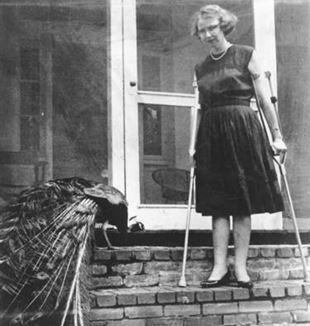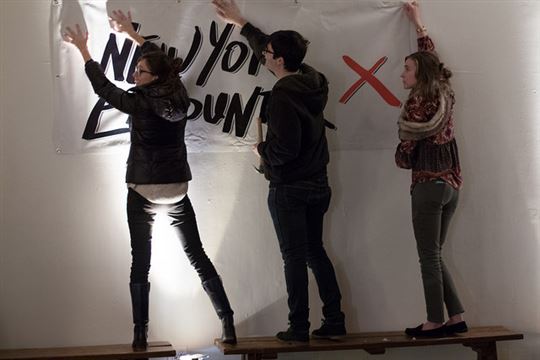
Flannery Returns Home
The exhibit on the American writer Flannery O’Connor presented at this summer’s Meeting of Rimini will be brought to the New York Encounter event, January 14-16, 2011, while later showings are planned in other U.S. cities.The exhibit on the American writer Flannery O’Connor presented at this summer’s Meeting of Rimini will be brought to the New York Encounter event, January 14-16, 2011, while later showings are planned in other U.S. cities. In the curators’ words, it is a “powerful antidote to the North American way of thinking about life, its limitations, and the fruits of Grace.”
American writer Flannery O’Connor teaches us through her work that fiction is the community where the mystery of liberty plumbs its true depths.
“Free will does not mean one will, but many wills conflicting in one man,” O’Connor wrote in a preface to the second edition of her novel Wise Blood. “Freedom cannot be conceived simply. It is a mystery and one which a novel, even a comic novel, can only be asked to deepen.” The power of the 2 novels and 31 short stories that O’Connor published in her abbreviated life arises from her eagerness as artist to say “yes” to delineating the chasm between mystery and manners precisely by taking the risk of being misunderstood. It came, in other words, from her willingness to accept, and work within, “Limit with Infinite Measure.” That is the title of the exhibition on O’Connor’s life and work that will be presented at the New York Encounter in January after it created major buzz during its inaugural staging for the Meeting in Rimini last August. “We went to Rimini knowing there was a risk because she is a very particular kind of writer who can be difficult to understand,” says Amy Sapenoff, one of a group of friends who created the O’Connor exhibit for Rimini and are now “editing” it to a smaller size for New York. “There’s this perception of her as a famous writer that misses the fact that she was an isolated person with a very strange sense of humor. We chose something of a misfit to present to a European audience.”
A year of discoveries. The exhibition, which will go to Dublin in December before arriving in New York, must be pared down by about one-third its size to fit the Encounter space. Much of the savings will come from mounting exhibit panels only in English rather than having to display them in Italian, too. As well, some panels that were necessary to explain racial attitudes in the American South during O’Connor’s life aren’t considered necessary for a North American audience. Such limitations of cultural knowledge were at the heart of the challenge of creating the original exhibit. Saying “yes” to those limitations gave the group of friends the solutions to a host of technical and narrative issues. “It was clear to us that the cultural question was huge–how do you communicate, not just articulate?” says Annie Devlin, who curated the Meeting exhibit and was a driving force behind its creation.
“How do you give a feel of the culture Flannery O’Connor lived in to people in Italy? How do you show what the red clay of Georgia looks like? There was this cultural abyss we had to leap over if we were going to say anything.” Making the leap required pushing to the essentials of O’Connor herself. It meant spending a year discovering who Flannery was as a person, not just extracting facts on her reputation as a writer. “We immersed ourselves in her. We spent our time together talking and thinking out loud about the things she was saying. I remember being on vacation at this big lodge in Colorado and Amy came over and I said to her, ‘Amy, I could just do this forever. I could sit in this spot forever and do the kind of learning that comes from having to communicate [O’Connor] to other people.” For Devlin, a doctoral student in theology at the Catholic University of America, interiorizing O’Connor was at the heart of the nature of the exhibit itself. Interiority permeated its deep structure, particularly the central element that was the reproduction of the house where the writer lived in Milledgeville, Georgia.
Moved by circumstances. “It was important to show the point of interiority where the person meets the mystery of God. [The house] is the most interior place but it is not only the most interior thing. It is only the most interior thing simultaneously taking place in the very concrete historical and biographical facts of Flannery’s life… showing the dimensions of the encounter that took place within a limit, an encounter that went on and on and was bottomless in a certain sense.” Moving so fully into that encounter was, Devlin admits, a paradoxical process since she had spent her academic life consciously avoiding O’Connor’s work. During the teamwork of creating the exhibit, her perspective shifted to regarding Flannery as one of the friends present in bringing it to life. She found being able to retreat to the quiet of the exhibit “a mercy” during the peak of the Meeting week.
“There were times it was exhausting, times things were asked of me I hadn’t had in mind, but it was so clear there was a presence and if I could say ‘yes’ to it, then suddenly it wasn’t grating or heavy. It was very beautiful, precisely in the frenzy.” She has discovered in the aftermath of Rimini that O’Connor continues to provide enduring guidance, solace, friendship.“The event of having worked with her has given me so much. She is getting into the nitty-gritty parts of my life and helping me not only to understand my life better, but to live it. She is getting inside and shaking me.” The re-mounting at the New York Encounter, as well as planned showings of the exhibit in Boston, Washington, and Steubenville, Ohio, will offer the opening for North American audiences to let O’Connor shake their understanding as well, Amy Sapenoff says. Her work, Sapenoff points out, is a powerful antidote to the North American tendency to see the fruits of grace as happy endings. A discovery at Rimini was the extent to which the exhibit opened visitors to her writing even if, like Annie Devlin, they had previously tried to read her and found her too dark, too forbidding. “Flannery O’Connor writes outside our experience and that is the profound interest of this proposal: what it says about limitations,” Sapenoff says. “Mystery is encountered by remaining true to the circumstances given to you”–moving us, as O’Connor herself said, toward the full depths of freedom.
*Director of the Centre for Cultural Renewal in Montreal, Canada.